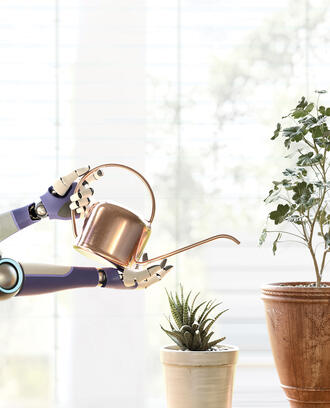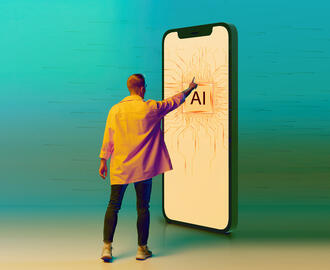Credit: Akacin Phonsawat / iStock
Though the metaverse has been most closely associated with elevated shopping and entertainment experiences for consumers, the industrial sector has pragmatic designs on using the technology to improve collaboration, optimize and enhance operations, and train manufacturing talent.
The industrial metaverse is being constructed with existing tools, including digital twins, artificial intelligence, high-fidelity simulations, extended reality, blockchain, 5G connectivity, and cloud and edge computing. And it will be instrumental in creating more resilient supply chains and localizing manufacturing, according to Siemens USA CEO Barbara Humpton.
“In a digital environment, we have the ability to build, experiment, and virtually use the forces of nature on something before it even exists and then make a decision about what we actually want to build in the real world,” Humpton said at a recent event hosted by the MIT Technology Review.
Humpton and other experts discussed how the industrial metaverse links real and digital worlds, creating an immersive environment where manufacturing workers can collaborate in real time while solving real-world business problems more easily and less expensively.
The industrial metaverse goes to work
The digital twin, a virtual model of a real-world object, is the cornerstone of the industrial metaverse. Next-generation digital twins will be photorealistic, physics-based, AI-enabled, and linked to a greater metaverse ecosystem, expanding their capabilities and further blurring the line between physical and digital spaces, according to a white paper about the industrial metaverse by MIT Technology Review and Siemens. Gartner expects the digital twin market to surge to $183 billion by 2031, while ABI Research is projecting the market potential for the industrial metaverse to reach $100 billion in 2030.
Expectations for the industrial metaverse are high for a number of reasons. Faster problem-solving is a key advantage, as is the possibility of recombinant innovation, especially as digital twin representations of physical assets make it far easier to iterate without building costly prototypes or interrupting plant floor operations.
Gartner expects the digital twin market will be $183 billion by 2031.
“If you take a system of components and subcomponents and they’re digital twins, you can recombine those in new ways,” said Marshall Van Alstyne, a Boston University professor and visiting scholar at the MIT Initiative on the Digital Economy. “It creates a sandbox or playground in which you can build and construct new things.”
Potential industrial metaverse use cases include the following:
Improved design and engineering. Team members from different departments or locations can work in a collaborative setting and innovate without the need for costly and time-consuming travel or extensive physical prototyping. The ability to combine photorealistic environments with different simulations allows for more extensive testing and validation of product designs or plant facilities in the virtual world, facilitating greater innovation.
Virtual commissioning and plant design. By using immersive digital twins, manufacturers can build out and commission their shop floors in the metaverse, ensuring optimized operations and resiliency. They can detect and correct errors without disrupting ongoing production or incurring unnecessary investment risks. Siemens used digital twin technologies to plan and simulate the construction of a 73,000-square-meter factory in Nanjing, China, leveraging factory data, production line data, performance data, and building information to test and validate the factory well before construction was initiated.
Enhancing operations. Through simulations and real-time data collection, manufacturers can garner insights used to optimize equipment, minimize downtime, and predict and prevent failures.
Upskilling employees. The metaverse gives employees remote access to expert skills and virtual training regardless of where they are physically located. Employees can receive in-depth, hands-on training on complex machinery in the virtual world without disrupting operations.
Implementing the industrial metaverse
As manufacturers dive deeper into the metaverse, they should keep the following in mind:
Related Articles
Interoperability and an open ecosystem are key to success. In order to benefit users, the metaverse demands an open ecosystem along with interoperability so data can flow between applications. Digital twins support this because they are representative of end-to-end systems, not individual assets or silos. “The trick is to make it all work together,” said Douglas Bellin, global lead of business development, Industry 4.0 and Smart Factories, at Amazon Web Services.
Multiphysics simulation plays a central role. Multiphysics simulation, which enables the behavior of a physical asset to be mimicked in the digital world, will be a key differentiator in the industrial metaverse, said Peter Koerte, chief strategy officer and chief technology officer at Siemens. “We are trying to solve real-world problems in the industrial metaverse, which means all the things have to behave exactly the same way as they do in real life,” he said.
Think globally, not locally. Manufacturers need to think beyond the efficiency gains of attaching a sensor to a single machine to ensure that it is operating at peak efficiency. Instead, they should consider a system-level view to experiment with how changes result in end-to-end optimization. “By taking data across all these different systems, you can globally optimize, perhaps replacing a set of components completely or resulting in something vastly more efficient by doing it a different way,” Van Alstyne said.
Create more value than you take. The promise of recombinant growth will depend on ecosystem partners sharing data and models. It’s important to establish new governance models and establish rewards that encourage metaverse participation. “The idea here is you need ideas you don’t have from people you don’t know, and that won’t happen if you’re not rewarding them,” Van Alstyne said. “If you create more value than you take, people will be willing to bring you their resources. If you don’t, they won’t.”
Read next: How data fuels the move to smart manufacturing



